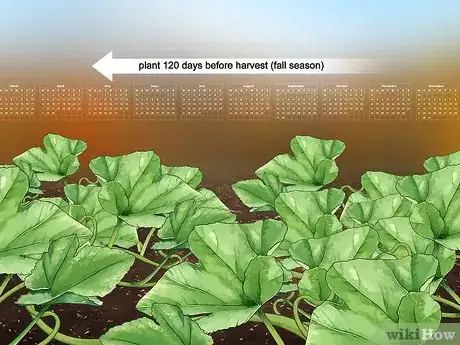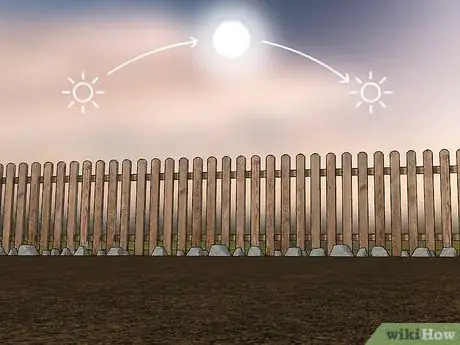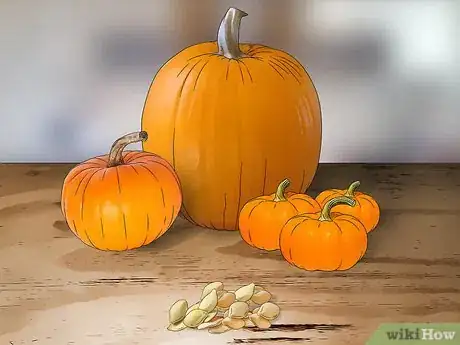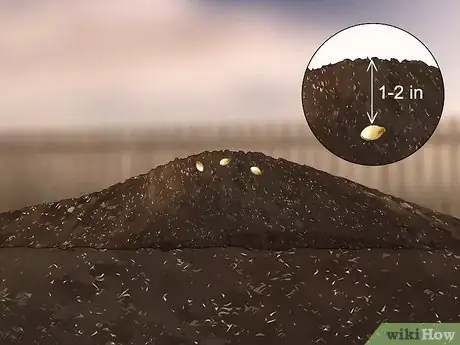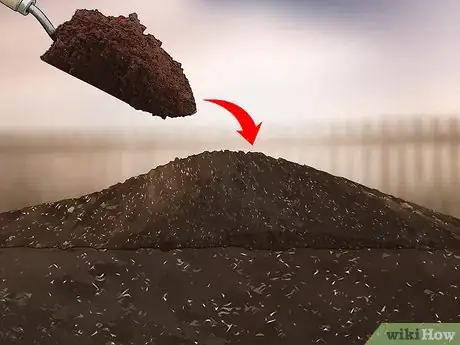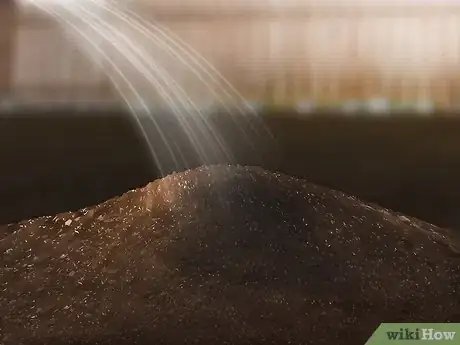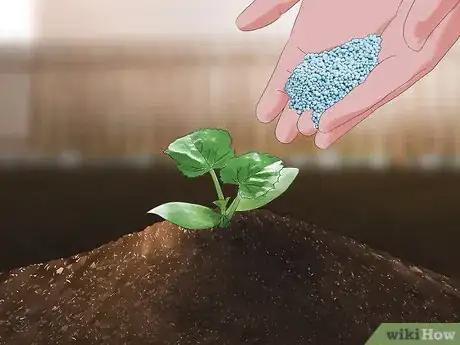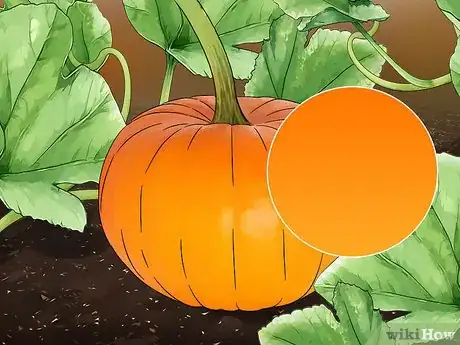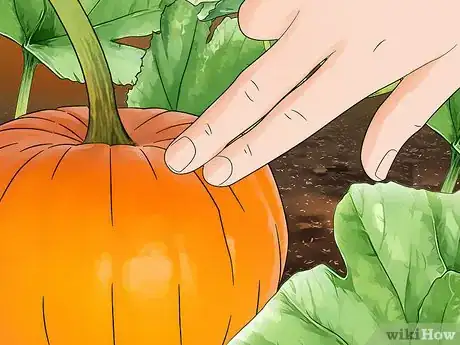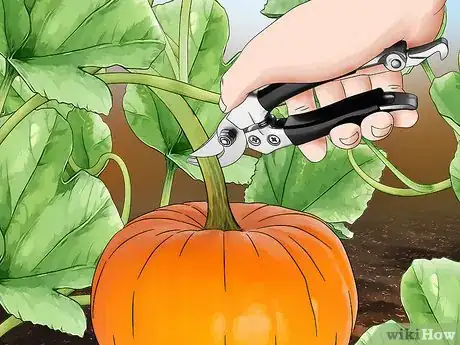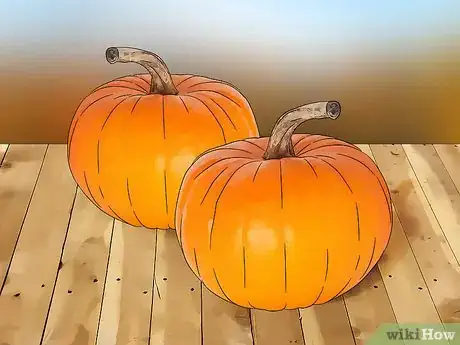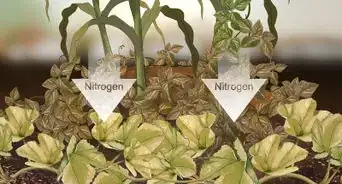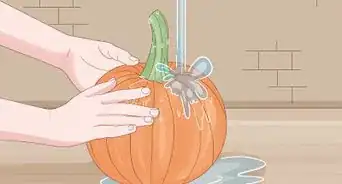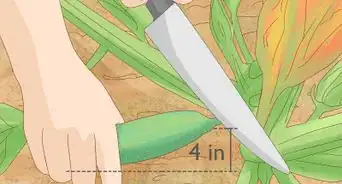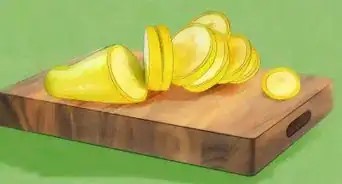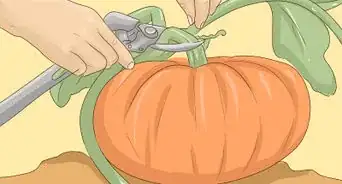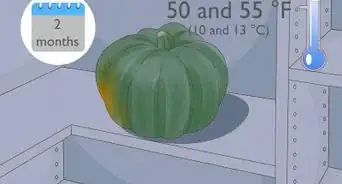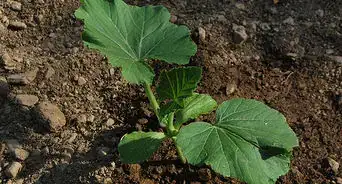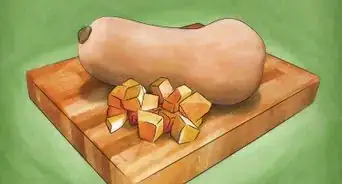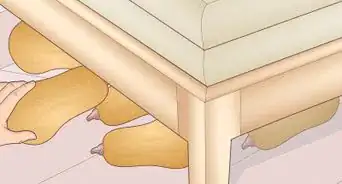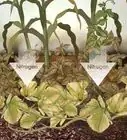This article was co-authored by Andrew Carberry, MPH. Andrew Carberry is a Food Systems Expert and the Senior Program Associate at the Wallace Centere at Winrock International in Little Rock, Arkansas. He has worked in food systems since 2008 and has experience working on farm-to-school projects, food safety programs, and working with local and state coalitions in Arkansas. He is a graduate of the College of William and Mary and holds a Masters degree in public health and nutrition from the University of Tennessee.
wikiHow marks an article as reader-approved once it receives enough positive feedback. This article received 14 testimonials and 91% of readers who voted found it helpful, earning it our reader-approved status.
This article has been viewed 591,982 times.
Pumpkins can be made into a sweet or savory dishes, their seeds can be roasted roast, and they serve as beautiful, bright fall decorations. Growing pumpkins is easy and inexpensive, since they grow well in many different regions. Read on for information on choosing a variety of pumpkin to plant, finding an environment that will help your plants thrive, and as well as growing and harvesting your pumpkins.
Things You Should Know
- Plant your pumpkins inside of dirt mounds in widely spaced rows before covering the planted seeds with compost.
- Water and fertilize the pumpkins regularly, while also keeping a sharp eye out for pests and weeds.
- When the pumpkins are bright orange and hard, cut them off at their stems to harvest.
Steps
Preparing to Grow Pumpkins
-
1Find out when to plant pumpkins in your region. Pumpkin seeds do not germinate in cold soil, so they need to be planted after the chance of frost has passed. Plan to plant pumpkins in late spring or early summer for a fall harvest. Pumpkins typically take 95 to 120 days to mature.
- If you celebrate Halloween and would like to have pumpkins in time for the holiday, plant them in late July. If you want it in early July, plant in early March.
-
2Choose a planting spot and prepare the soil. Pumpkins grow on vines and need a good amount of space to thrive. Choose a place in your yard with the following qualities:
- 20 or 30 feet (6.1 or 9.1 m) of open space. Your pumpkin patch doesn't have to take up your whole yard. You can plant it along the side of your house, or along the fence in your backyard.
- Full sun. Don't choose a spot under a tree or in the shadow of a building. Make sure the pumpkins will get plenty of sun all day long.
- Soil with good drainage. Clay-based soils don't absorb water quickly, and aren't as conducive to growing pumpkins. Choose a spot that doesn't have standing water after heavy rains.
- To give the pumpkins an extra boost, prepare your soil beforehand by composting it. Dig large holes where you plan to plant the pumpkins and fill them with a compost mixture one week before planting.
Advertisement -
3Choose pumpkin seeds. Go to your local nursery or order seeds from a catalog to use in your pumpkin patch.[1] There are many different varieties of pumpkins, but for the home grower's purposes they fall into three main categories:
- Pie pumpkins, which are meant to be eaten.
- Large decorative pumpkins that can be carved into jack o'lanterns. The seeds in these pumpkins are edible, but the flesh is not flavorful.
- Small decorative pumpkins, often called mini pumpkins.
Planting the Pumpkins
-
1Plant your seeds in "hills." Build a small mound of dirt and plant the seed 1–2 inches (2.5–5.1 cm) deep. The hill helps improve soil drainage and allows the sun to heat the soil faster, speeding up germination.
- Plant 2 or 3 seeds within a few inches of one another, in case one doesn't sprout for some reason.
- It doesn't matter which end of the seeds points up. If the seeds are viable, they will grow either way.
-
2Plant pumpkins in widely spaced rows. If your pumpkin variety grows along creeping vines, space the hills in the same row 12 ft (3.7 m) apart, and space the rows 6 to 10 ft (1.8 to 3 m) apart, depending on variety size. "Bush-type" varieties that grow on shorter vines need 8 ft (2.4 m) of space in all directions.[2]
-
3Cover the planted seeds with compost. If you composted the soil before planting, you can skip this step. If not, add a thin layer of compost or mulch in the areas where you planted seeds. The compost will help keep weeds out and nourish the seeds.
- With proper care, the pumpkin plants should sprout within about a week.
Caring for the Pumpkin Plants
-
1Water the pumpkin plants when the soil moisture is low. Pumpkin plants need a lot water, but they shouldn't get too much. Make a habit of watering them when the soil seems a little dry, rather than adding more water to wet soil. Deep, infrequent waterings are ideal.
- When you do water the plant, use a lot of water and let it soak deep into the soil. Pumpkin plants' roots run several inches or feet down, depending on the stage of growth, and it's important that the water reaches them.
- Try not to get water on the pumpkin leaves. This encourages the growth of a fungus called powdery mildew, which can cause the leaves to wither and the plant to die. Water in the morning, rather than at night, so any water that gets on the leaves has time to dry in the sun.
- When the pumpkins themselves begin to grow and turn orange, decrease the amount of water you use. Stop watering entirely about a week before you plan to harvest the pumpkins.
-
2Fertilize the pumpkin plants. When the plants first sprout (in about a week or two), adding fertilizer encourages health pumpkin plant growth. Go to your local nursery and ask for a fertilizer you can add to your pumpkin bed.
-
3Control weeds and pests. In order to make sure your plants produce healthy pumpkins, you'll have to monitor them throughout the growing process.
- Weed the patch often. Don't let the growth of weeds crowd out the pumpkin plants or absorb the nutrients they need to thrive. Plan to weed a few times a week.
- Check the pumpkin leaves and blossoms for beetles, which eat plant tissue and ultimately kill the pumpkin plant. Scrape them off the plant a few times a week.
- Mulch around your pumpkins to keep weed pressure down and conserve soil moisture.
- Aphids are pests that threaten a lot of garden plants. They can be found on the undersides of the leaves, and if you don't take care of them, they'll kill the plants quickly. Spray them off with water in the morning so the leaves have time to dry.
- If necessary, use an organic pesticide to rid your plants of pests. Ask about products at your local nursery.
Harvesting the Pumpkins
-
1Check to see if the pumpkins are ready. The pumpkins should be bright orange in colour (depending on the species) with a hard shell. Their stems and often the vine itself should be starting to dry out and wither.
-
2Don't harvest pumpkins that are still soft. They won't keep for more than a few days before spoiling.
-
3Cut the pumpkins' stems. Use a pair of shears to cut the stem, leaving it a few inches long. Don't break off the stems, since this will cause the pumpkins to rot.
-
4Store the pumpkins in a cool, dry place. Keep them away from humidity, damp, and direct sunlight. They do not need refrigeration. Pumpkins keep for many months after they have been harvested.
- A mild chlorine rinse before storage can discourage mold and fungi. Use a mix of 1 cup (240 mL) household chlorine bleach and 5 gallons (18.9 L) cold water.[3]
Expert Q&A
Did you know you can get expert answers for this article?
Unlock expert answers by supporting wikiHow
-
QuestionHow long does it take from planting a seed to harvesting a pumpkin?
 Andrew Carberry, MPHAndrew Carberry is a Food Systems Expert and the Senior Program Associate at the Wallace Centere at Winrock International in Little Rock, Arkansas. He has worked in food systems since 2008 and has experience working on farm-to-school projects, food safety programs, and working with local and state coalitions in Arkansas. He is a graduate of the College of William and Mary and holds a Masters degree in public health and nutrition from the University of Tennessee.
Andrew Carberry, MPHAndrew Carberry is a Food Systems Expert and the Senior Program Associate at the Wallace Centere at Winrock International in Little Rock, Arkansas. He has worked in food systems since 2008 and has experience working on farm-to-school projects, food safety programs, and working with local and state coalitions in Arkansas. He is a graduate of the College of William and Mary and holds a Masters degree in public health and nutrition from the University of Tennessee.
Food Systems Expert
-
QuestionDon't seeds need light for germination? Won't covering them with compost stop them growing?
 Andrew Carberry, MPHAndrew Carberry is a Food Systems Expert and the Senior Program Associate at the Wallace Centere at Winrock International in Little Rock, Arkansas. He has worked in food systems since 2008 and has experience working on farm-to-school projects, food safety programs, and working with local and state coalitions in Arkansas. He is a graduate of the College of William and Mary and holds a Masters degree in public health and nutrition from the University of Tennessee.
Andrew Carberry, MPHAndrew Carberry is a Food Systems Expert and the Senior Program Associate at the Wallace Centere at Winrock International in Little Rock, Arkansas. He has worked in food systems since 2008 and has experience working on farm-to-school projects, food safety programs, and working with local and state coalitions in Arkansas. He is a graduate of the College of William and Mary and holds a Masters degree in public health and nutrition from the University of Tennessee.
Food Systems Expert
-
QuestionWhat is the difference between a male and female pumpkin flower?
 Community AnswerThe female has a bulb right underneath the flower. The males are thin and straight.
Community AnswerThe female has a bulb right underneath the flower. The males are thin and straight.
Warnings
- Pumpkin leaves will even climb nearby trees or wall if given the opportunity. A house a person once bought had an overgrown pumpkin patch with a pumpkin growing on the roof!⧼thumbs_response⧽
- Pumpkins are prolific growers - they tend to take over their part of the garden. Keep them apart from other plants so that they have lots of room to grow. Wherever a pumpkin starts growing, any plants underneath will be crushed - keep an eye on emerging pumpkins and gently move them and their stalk to a slightly different spot if they are crushing something else. Sometimes they will even crush each other!⧼thumbs_response⧽
- Squash vine borers are a major pest for North American pumpkin crops. Check the vines regularly for wilting leaves, holes, or sawdust-like material so you can start treatment early.[4]⧼thumbs_response⧽
Things You'll Need
- Pumpkin seeds jk
- Shovel, trowel, spade
- Decent soil and a large area of garden space
- Regular watering
- Compost
- Organic Pesticide (optional)
References
- ↑ https://www.realsimple.com/holidays-entertaining/holidays/halloween/how-to-plant-pumpkin-seeds
- ↑ http://www.vegetablegardener.com/item/5523/how-to-grow-pumpkins
- ↑ http://www.vegetablegardener.com/item/5523/how-to-grow-pumpkins
- ↑ http://www.almanac.com/pest/squash-vine-borer
- Videos provided by GrowVeg
- http://www.vegetablegardener.com/item/5523/how-to-grow-pumpkins
- http://urbanext.illinois.edu/pumpkins/growing.cfm
About This Article
If you want to grow a pumpkin, plant your seeds in late spring or early summer. Choose a spot with good soil drainage and full sun, then pat the dirt into a small hill, burying the seed 1 to 2 inches deep in the hill. Cover the hill with a thin layer of compost or mulch and water the pumpkin plants whenever the soil seems a little dry. However, you should avoid getting water on the pumpkin leaves, as this can lead to the growth of mildew. Harvest your pumpkins when they are bright orange with a hard shell. For more tips from our Professional Gardener reviewer, including how to care for the pumpkin plants while they're growing, keep reading!
